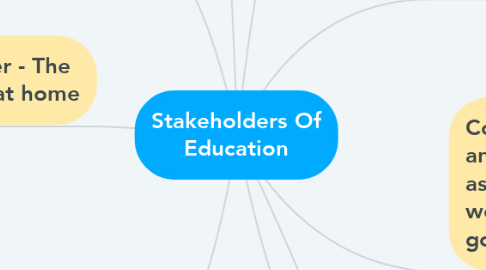
1. Student - The learner themselves.
1.1. The student can help themselves by being an advocate for their own education and by being clear about what they need and want. The student can also try to discover their own individual learning style.
1.1.1. The educational leader should know their student and be receptive to their individual needs. The educational leader should aim to nurture leadership qualities in their students.
2. Parent/ Guardian/ Partner - The learners’ direct support at home
2.1. This stakeholder can support the learner by being interested in what the student is learning. Not teaching the student, but rather being taught by the student as the learner shares their knowledge. This stakeholder is very useful in managing motivation to increase engagement of the learner also.
2.1.1. The educational leader can support the parent by hosting platforms of communication about issues that are relevant to the needs of both the parent and student. Communication about leadership, learning types, mental health, student achievements are essential and should be easy and fun to contribute to.
3. Teacher Support- Educational Assistant
3.1. This stakeholder has to know their student intimately. Educational assistants are great support for students, for example reading assistance, behavioural aid and students with special needs. Pre-empting the necessities of the learner is critical.
3.1.1. The educational leader can support the educational assistant by encouraging conversations around transformational leadership and inspire them to reflect the qualities we want to see in the learner.
4. Teacher- The Leader in the Classroom
4.1. The Teacher can support the student by creating an inclusive and supporting environment that fosters mutual respect and encourages risk taking in the pursuit of lifelong education.
4.1.1. The educational leader can support the teacher by being a conduit between the other stakeholders in education and offering professional development opportunities for teachers to continue their own learning.
5. Who is the Stakeholder
5.1. How Can the Stakeholder help the Learner?
5.1.1. How can the educational Leader help the Stakeholder?
6. Principals – The Leader of the school or educational institution.
6.1. The Principal can also support the student by creating an inclusive and supporting environment that fosters mutual respect and encourages risk taking in the pursuit of lifelong education. The principal should also be a support for the teacher and their needs in delivering their content in a positive working environment.
6.1.1. The educational leader can help the Principal though a constant focus on Leadership initiatives within the school and through the active connection of the different stakeholders in education to create opportunities of shared growth.
7. Community – Communities have an invested interest in students as these people are the future workforce, business owners and government officials.
7.1. The community can support the learner by getting involved in the school community. Businesses can support school initiatives in the community, for example, sponsor a fun run.
7.1.1. The educational leader can support the community by producing future leaders that are empathetic and action to achieve equitable social change.
8. Ministry of Education – The governing body of qualified teaches in the Provence.
8.1. The ministry supports students by setting a high level of professional requirements, guidelines and standards. This ensures quality teaching and support staff that and that educational recourses are shared and distributed equally.
8.1.1. The educational leader can support the ministry by being professional and by exemplifying the standards of practice. Also, by being a researcher in the field to constantly review theories and best practices.
9. Government Representatives – Have a duty to legislate law in Canada.
9.1. In Canada the right to education is contained in provincial/territorial education acts. These acts typically provide access to public education for children from ages 5/6 years to 18/21 years of age. In addition, human rights acts ensure both access as well as protection from discrimination.
9.1.1. The educational leader has a legal obligation to work within the framework of these legislated acts.
